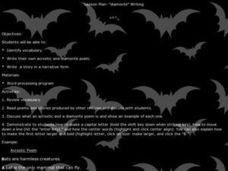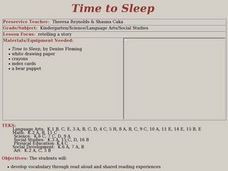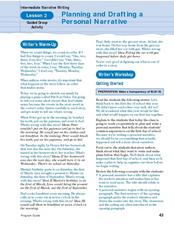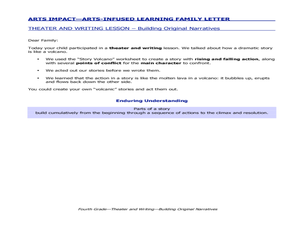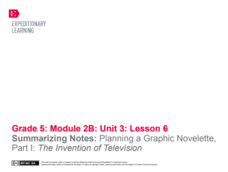Midland Independent School District
Drama
Ten drama lessons are the perfect addition to your language arts or theater class. With a focus on script elements, plot development, and parts of a dramatic story, the lessons guide young playwrights through the steps of telling a story...
Curated OER
Animal Diaries
Students read Diary of a Worm by Foreen Cronin. In this journal writing lesson plan, students research an animal and write a diary by their animal. Students apply the research they've completed in their writings. Students share their...
Curated OER
Comprehension Through The Very Hungry Caterpillar
Students sequence seven events from "The Very Hungry Caterpillar" by matching the correct event with the day of the week. They recall details from the story as they unscramble words on a worksheet.
Curated OER
The Very Hungry Caterpillar
First graders, after reading The Very Hungry Caterpillar, place the story in its correct order of sequence. They place any set of events (situation) in their correct order.
Curated OER
Newscast From An Ancient City
Seventh graders produce a newscast from an Ancient Roman city. In this journalism and history activity, 7th graders work in groups to dramatize a historical event from the Roman Empire. students sequence the events, role-play, and create...
Curated OER
Writing Application: The Canterbury Tales
Students read stories from The Canterbury Tales by Geoffrey Chaucer and create their own tale. In this writing applications instructional activity, students read the tales and analyze the specific details that Chaucer use. Students work...
Curated OER
Map the Path in My Father's Dragon
Students listen to Ruth Stiles Gannett's book My Father's Dragon. They predict the outcome of the story. They discuss the events in the story. They sequence the events in the story.
Curated OER
Diamonte Writing
Students discover poetry while practicing their storytelling skills. In this language arts lesson, students read diamonte and acrostic poems written by other students on the Internet. Students create their own narrative...
Curated OER
Tell a Tale
Pupils create a class story using picture cards. Each student picks a card, tapes it to the board, and retells the story in sequential order using the words then and next.
Curated OER
Silly Sally
Students examine character traits. In this literary elements lesson, students read 2 short stories paying special attention to the actions and descriptions of the characters. Students add themselves as characters in the story.
Curated OER
Caribbean Islands
Second graders discover the characteristics of the Caribbean Islands. After being read a story, they use maps to locate the locations mentioned. They recall the sequence of events in the story and identify the cultural traits and...
Curated OER
Time to Sleep
Students develop vocabulary and retell a story that they have just listened to.
Curated OER
Cuentos
Students revise Spanish mystery stories. They sequence the events from a group's mystery story and suggest revisions for the setting. They revise their stories using the suggestions from classmates and describe characters in folktales....
Curated OER
The Artist As Storyteller
Students practice the art of storytelling by examining scroll writing techniques of Asia and applying them to a monthly story of their own classroom. This instructional activity is in two parts (Part II continues throughout the school...
Curated OER
Comprehension: Create a Summary from a Narrative Text
If your class can sequence events in a story, are pretty good at retell, and can identify the main point, they are probably ready for reading comprehension through summarizing. This lesson provides a teacher's script that facilitates...
Hawaiʻi State Department of Education
Cinderella
Reading fairy tales is so much fun! Learners use dramatic play to assist them in defining and expressing the main theme found in the story of Cinderella. Each group is given a story card and will create a tableau based on the main point...
Curated OER
"The Drum"
Second graders read and discuss the folktale "The Drum" from India. They also answer story comprehension questions, complete an adjectives and verb worksheet, and label a map of India. Students sequence events from the story and make...
Curated OER
Planning and Drafting a Personal Narrative
Bring your learners together to write a class narrative about the first day of school. Start off by teaching them about sequence with a quick oral activity. Then, work together to fill out a story map. Finally, compose the class...
Curated OER
Order! Order!
Polish organization skills in your youngsters. With this lesson, they are introduced to the trait of organization and participate in activities that reinforce organization. They cut apart a familiar story, receive different...
Curated OER
Building Original Narratives
Fourth graders act out and write original narratives. In this theater meets writing lesson plan, 4th graders work in groups to create original narratives; after students act out their story, they write it down as a narrative.
Curated OER
2nd Grade - Act. 04: What Time Is It?
How do you teach time? Using various stories, 2nd graders will learn about the concept of a daily schedule to develop a sense of self. They will complete a time of day chart and learn about the basic concepts of time beyond a minute....
Scholastic
Ruby Bridges: A Simple Act of Courage, Grades K-2
A civil rights movement instructional activity designed specifically with the Common Core State Standards in mind, young learners are introduced to the story of Ruby Bridges as the first African American child to attend an all-white...
University of Arizona
Fusing Firecrackers with Narrative
Improve your youngsters' descriptive writing. They study an object and write about what they see as a warm-up, then they read an excerpt from Paul Guest's memoir, One More Theory about Happiness. The next part of the...
EngageNY
Summarizing Notes: Planning a Graphic Novelette Part 1: The Invention of Television
What's the story? Learners create the first of four storyboards about the invention of the television, incorporating narrative techniques and descriptive details. Next, they offer and receive feedback by participating in a peer critique...







